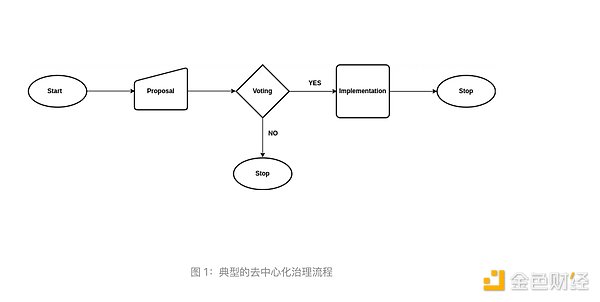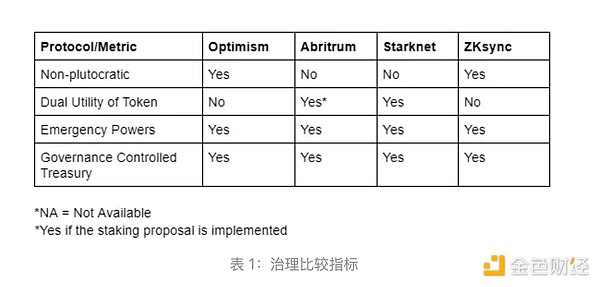Author: Superchain Eco Source: mirror Translation: Shan Ouba, Golden Finance
What is governance and decentralization
Decentralization refers to a control and coordination structure in which participants are part of a distributed network and members or entities on the network do not need to emphasize trust in any particular entity. The system is designed to minimize trust while ensuring that the network can achieve its goals. Governance is a method of achieving decentralization using blockchain technology, which usually provides support for decision-making processes, operations, and protocol development through smart contracts and tokens owned by governance participants.
The rest of this article will provide a comparative analysis of the various approaches to solving governance problems adopted by Optimism and other comparative layer 2 networks such as Arbitrum, Starknet, and ZKsync.

Optimism: A two-tier governance approach
Optimism’s core governance approach is a non-plutocracy system that is not controlled by any single entity or a few entities. This means that token holders do not have the sole say in protocol upgrades, resource allocation, and innovation. The accumulation of OP governance tokens will not help any entity capture network value, as Optimism’s governance is based on a bicameral architecture, where the second component (called the Citizen House) acts as a check and balance mechanism for the Token House and vice versa.
Optimism Collective calls itself an experiment in governance, designed to iterate constantly as they believe vision can sometimes be at odds with value creation. The Token House consists of holders of the OP governance token, who can either participate in voting directly with their tokens or delegate their tokens to entities they believe share their values to vote on their behalf. The Citizen House, on the other hand, consists of Citizens, individuals who have demonstrated acts of goodwill within the Optimism ecosystem. Citizenship is granted by soul-bound NFT tokens and is non-transferable.
Compared to the Token House, where a single entity can have a large number of votes by virtue of the number of tokens they own, citizens only have one vote, furthering the democratic process. While the Token House’s primary role is to vote on protocol upgrades and project incentives, the Citizen House primarily manages retroactive public goods funding, in addition to ensuring that the protocol pursues its long-term vision and is not controlled by any one entity by ensuring a people-centric governance structure. The Token House can veto citizenship to provide a check on the power of the Citizen House. A core modus operandi of the Optimism Collective is that one House has a core set of responsibilities that can be overruled by another House and vice versa.
Arbitrum: Arbitrum DAO, Delegation, and Staking Methods
The Arbitrum Layer 2 network is governed by the Arbitrum DAO, which consists of a community of $ARB token holders who can propose and vote on technical changes developed for the network. Token holders can participate in governance directly or through elected representatives, called delegates. The Arbitrum DAO has just passed a proposal to introduce staking of $ARB tokens and transform it from a pure governance token to a dual utility token. Governance on Arbitrum will be based on a liquid staking token called the Staked ARB Token ($stARB). The rationale for the proposal is to increase the value of $ARB and increase participation in governance, as DeFi protocols that lock $ARB are incompatible with governance.
Arbitrum is looking to increase governance participation as only ~10% of the $ARB circulating supply is actively used for governance. The Arbitrum DAO is implemented as a smart contract and is responsible for managing the built-in treasury system. It also has a Security Council mechanism that allows protocol upgrades to bypass the governance process in emergency situations. The Security Council is an important part of the governance structure and is responsible for making decisions in these critical situations. The Security Council members are elected by the Arbitrum DAO. The overall governance structure of Arbitrum is plutocracy as $ARB token holders are the main arbiters of the system.
Starknet: Dual Utility Tokens and Virtual Governance Approach
Starknet’s governance mechanism is unique in the Layer 2 space as it has a dual utility token that is not used directly for voting but rather abstracted away as voting rights. Starknet’s base token, STRK, is not a direct governance token as it is used as a fee payment token on the Starknet network. To achieve its dual utility, STRK must be wrapped as vSTRK to be used for governance. STRK tokens are not compatible with governance; only vSTRK can be used directly to vote for proposals or appoint delegates with the same voting power as vSTRK tokens.
vSTRK tokens can be unwrapped into STRK, but each wrapping and unwrapping operation incurs gas costs. Another fundamental difference in the Starknet governance mechanism is "progressive governance," an approach that continuously pushes network components toward full decentralization. With this philosophy, Starknet has various entities and committees that guide certain aspects of the protocol. Some of these entities include the Starknet Governance Council, the Builders Council, and the Starknet Foundation.
ZKsync: Three-Body Governance
ZKsync's governance approach is built around three fundamental principles: resilience, distribution, and task consistency. It ensures that no single entity has unilateral power over the protocol, thereby promoting long-term stability and community control. The system is decentralized, with decision-making power spread across three bodies: the Token Assembly, the Security Committee, and the Guardians.
The Token Assembly consists of token holders and delegates who can propose and vote on protocol changes. The Security Committee oversees technical upgrades and has the authority to address security risks. Guardians ensure that all proposals are consistent with ZKsync's core values and can veto inconsistent decisions. This hierarchical governance structure establishes checks and balances that promote transparency, security, and alignment with ZKsync’s mission
Governance Comparison Summary

The above table shows that Optimism, Arbitrum, ZKsync, and Starknet all retain emergency powers to implement changes in an emergency, bypassing the governance process. These emergency powers belong to the protocol’s security committee. Similarly, all censored networks have treasuries controlled by the governance process. Optimism and ZKsync have non-plutocracy governance structures that do not emphasize economic power.
Simply having more governance tokens will not create overly large influence. Starknet has a dual utility token, and Arbitrum’s governance token may soon play a role beyond voting if staking proposals are implemented. On the other hand, Optimism and ZKsync governance tokens remain pure governance tokens for the time being.
Conclusion
This article explored the current governance landscape of four leading Ethereum layer 2 networks: Optimism, Arbitrum, Starknet, and ZKsync. It started with a brief introduction to decentralization and governance, and then analyzed the governance mechanisms of various protocols. The main conclusion is that Optimism has a bicameral system where power is controlled by token holders and vice versa. Arbitrum governance is led by the Arbitrum DAO through $ARB token holders, a plutocracy that emphasizes the number of tokens held. Arbitrum is trying to increase participation and drive value accumulation for governance token holders by introducing staking in its governance ecosystem.
Starknet governance is also plutocracy, with a dual-utility governance token, but it has various committees and boards that shape the protocol. The ZKsync governance system is designed around the principles of separation of powers and checks and balances. By design, no single individual or entity has the power to change the ZKsync protocol.
While decentralization is a spectrum, protocols should be as decentralized as possible to avoid censorship and capture by malicious actors. All reviewed protocols could further decentralize the emergency powers of the Security Council and explore ways to remove such power through innovative experiments that put the community at the center of governance.
 JinseFinance
JinseFinance
 JinseFinance
JinseFinance JinseFinance
JinseFinance JinseFinance
JinseFinance JinseFinance
JinseFinance JinseFinance
JinseFinance JinseFinance
JinseFinance Future
Future Cointelegraph
Cointelegraph Cointelegraph
Cointelegraph Cointelegraph
Cointelegraph